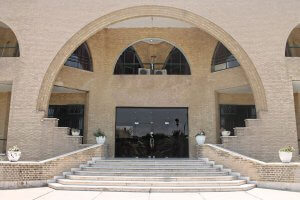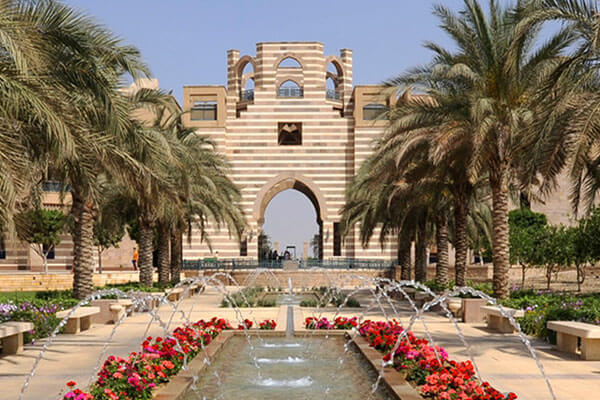
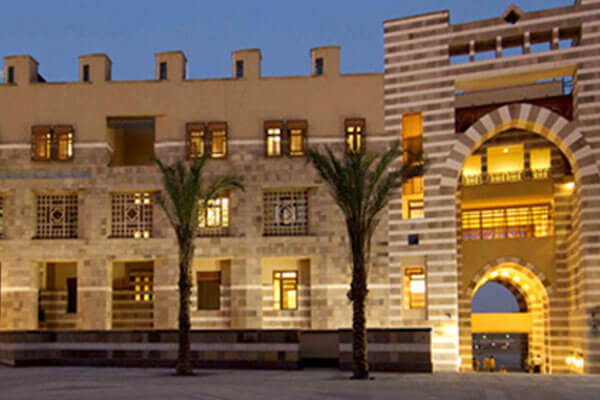
The Project
The built area of the campus will comprise some 200,000 square meters, set on a 260-acre site, with an estimated budget of over $200mil for construction. AUC currently occupies 100,000 square meters of owned and rented space on approximately 7 acres in several locations in downtown Cairo. AUC’s new campus is located some 35 kilometers to the east of downtown Cairo, in the planned community of New Cairo, a development with a projected population of 2 to 3 million people, now a desert characterized by petrified forest remnants.
The Selection Process for the Master Planner / Urban Designer
In 1998 the client asked for RFPs on an international basis. 58 firms responded. BDC was short-listed among the first 25, then it was short-listed again among the next six firms, who were invited to participate in a design competition. On September 16, 1999 AUC announced that the architectural firm of Boston Design Collaborative had been selected to develop the Master Plan / Urban Design for the new campus. The master plan for the new campus as a full-fledged university includes classrooms, offices, and laboratory space for the three principal schools–The school of Business, Economics and Communication, The School of Humanities and Social Sciences, and the School of Sciences and Engineering. Additionally there will be University Research Centers, a main library, media and technology center, athletics facilities, physical education, recreational facilities, student housing,student services, campus information center, administration, faculty housing, day care, and physical plant.
BDC approach to the Master Plan / Urban Design of the American University in Cairo
Based on our experience with the design of the Aga Khan University in Karachi, Koc University of Istanbul, and an in-depth study of the architecture of the Middle East, we conceived the design of the entire AUC campus as the architecture of continuous interior spaces that surrounds the observer rather than the architecture of isolated buildings that stand apart from him. In this kind of architecture, voids become more important than buildings and the design will become based on the sequence of open spaces and courtyards each designed for different functions of movement, introspection, interaction, and spiritual rejuvenation. As these spaces unfold in a rhythmic and hierarchical way before the eye of the pedestrian, they impart a delightful sense of surprise. They acquire their meaning through the movement of the user in these spaces. Architecture acquires a kinetic quality.
Our approach to design addresses the rising desire for identity affirmation in the Middle East. Through our design we study the social conditions, the history, literature and arts of the people we serve. Our approach to design is holistic. Having learned from many Islamic examples of architecture, we consider the organization of spaces as the “body” of architecture, and the design of surfaces both exterior and interior as the “soul” of architecture. We design the spaces to respond to the functional program, and the way of life of the users. We design the exterior and interior surfaces to recall the cultural memory of the people. We try to understand the importance of traditional arts of the region, and to provide a modern rendition of it for recalling the cherished ideas and aspirations of the people.
STAFF BY PROJECT:
- Mozhan Khadem (Principal in charge, Director of Design)
- Marwan Bakri
- David Duhahn Choi
- Caroline Darbyshire
- Marcus Elkatsha
- Rami el Samahy
- Felipe Eguia
- James Heroux
- Jacob Kain
- Tara Khadem
- James May
- Heather McLay
- Lee Moreau
- Hubert Murray
- Branko Novakovic
- Nasser O. Rabbat
- Adolfo Peña-Iguaran
- Paul Valtchev
- Vassia Vassileva
- Mert Yilmaz
- Ilhan Zeybekoglu
- Landscape Architect: Carol Johnson Associates, Boston
The Competition
List of Invited Competitors:
- Boston Design Collaborative/ CRJA
- Cannon
- Ellerbe Becket
- The Hillier Group
- RTKL Associates
- Sasaki/
Community Design Collaborative
Jury:
- Ismail Serageldin; architect and V.P. World Bank.
- Charles Correa, architect.
- Ricardo Legoretta, architect.
- John Hayes, AUC trustee and
Chair Relocation Committee. - Elizabeth Driscoll, AUC trustee.
- Tim Sullivan, AUC Provost.
- Kenneth Toepfer, former
AUC Executive Vice President.
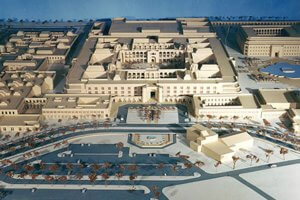
Armed forces Medical Center, Rawalpindi, Pakistan
The Project This project was won in an international competition by Mozhan Khadem, Director of Design and Principal-in-Charge. 14 international firms participated in the competition.
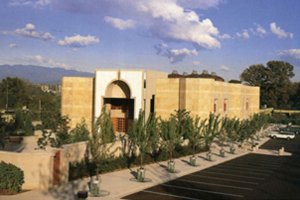
Burnaby Jamatkhana, Burnaby, British Columbia, Canada
The Project Mozhan Khadem was commissioned to provide specialized consulting services with regard to interior design and surface treatments (interior and exterior) of the Burnaby
